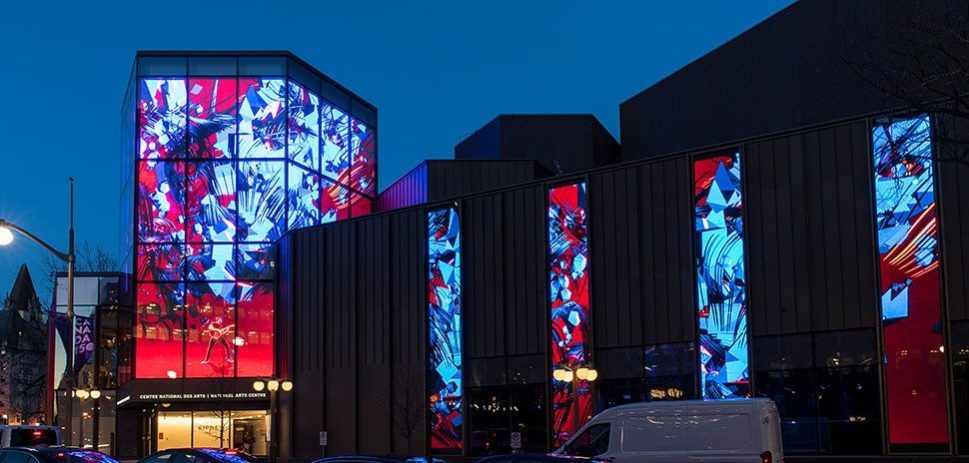In conversation with NAC’s Heather Gibson about the 2018-19 season

Photo by Trevor Lush
Since taking the reigns as Executive Producer of the NAC Presents series a year and a half ago, Heather Gibson has had the vision of bringing something new to the table. She recognizes the NAC’s importance in developing emerging artists across Canada and supporting the Ottawa/Gatineau region’s local arts scenes, and to that extent, has lived up to her word and is building upon her vision. The NAC is becoming a more accessible stage for local artists to cut their teeth, as well as garner more exposure and develop their audiences.
Moreover, her work in challenging the music industry’s problem of unbalanced opportunities for women and marginalized people has allowed the NAC to be a shining example of how music programming should be conducted. She is steering the ship in the right direction, and demonstrating that achieving diversity and gender parity isn’t rocket science.
Upon the announcement of NAC’s 2018-19 season programming—which includes over 55 shows—I spoke with Ms. Gibson on the phone about these topics, and the new theme of Changing Landscapes.
Interview with Heather Gibson
Can you speak about the theme of changing landscapes and what that represents?
I didn’t book with a theme in mind, it’s just the theme that came. We wanted to book the artists that we wanted, and then the theme of “changing landscapes” is what it ended up being. It represents many things—changing of landscape here at the NAC, changing direction, the idea that Canada isn’t one thing and that it’s a collection of art and influences. That’s how they all kind of fit into that theme.
What role do you see the NAC playing with respect to gender parity and diversity in the grand scheme of the Canadian Music industry?
I don’t think gender parity is hard. It’s really challenging to understand why people will program an entire festival where there’s one female artist over nine days or something. With all respect due to my colleagues, I think that they either don’t have the same goals or aspirations as the National Arts Centre, or they just don’t know how to do their job very well. Gender parity and diversity is part of doing your job as an Artistic Director—in any kind of art. So, the role of the NAC is far deeper than presenting a diverse program, it’s about getting to the root of the issue and what the NAC can contribute to changing that. I don’t find it difficult to book like that, but I hear a lot of my peers saying that it is difficult to book diverse acts at a headlining level.
There are arguments to be made that there’s a short list of women who will perform for $100k or $50k, but then there needs to be a focus on booking women in a secondary role, underneath the headliners and on the B-stage. Bringing up the development of women like we have been with guys for decades is important. We have a responsibility at the NAC to ask the tough questions, like why are there so few female conductors? We need to figure out how we can develop female conductors. Or if there are only a handful of indigenous artists who fit the bill, then how do we make sure there are more of them in the future?
It’s difficult, and a lot of those conversations are systemic. There’s a whole ecosystem here that hopefully we can influence, and the audience is involved in that. If they want to support diversity, then the audience needs to come to those shows.
Traditionally the NAC Presents and the NAC Orchestra have been their own separate entities. Can you speak to how that collaboration came to be this season?
Yeah, the series is called Sessions. Part of the challenge is that the Orchestra is booking into 2020 right now, so when I first got here and expressed interest in this collaboration, they were very keen on the development of Canadian arrangers and composers, as well as audience development. On my side of things, I’m interested in artistic development of singer-songwriters. With people like Lynn Miles, we’re doing a full-commission project from start to end with her, so archiving great Canadian songwriters is important as well. Through the years you’ll see more and more of that, and Lynn is actually the first one.
It was a conversation we’ve had, and the NAC Orchestra and Andrew Shelley (Music Director) have been very supportive of this idea. They’ve been keen on seeing what we can do. We have a mash of things this year, Lynn Miles and Tom Wilson are doing the first one on October 4th. Tom is coming with his book and doing the show he did with the Hamilton Philharmonic, and Lynn is being commissioned. We’re doing six or seven with her on this first one, and then eventually over a series of shows she’ll have a full one in a year and a half. And then Stars are a full commission in December, and that is giving us the opportunity to work with a lot of great Canadian arrangers, and probably a new Canadian conductor.
There are a lot of different parts to it, Patrick Watson has a lot of these symphony shows under his belt and I think there will be an opportunity to do a lot of neat stuff with him as his compositions have been getting more and more intricate. It will be interesting with the band in front of the orchestra. The Johnny Reid Christmas show is allowing us to work with local choirs and have him front this thing that will seem like a community Christmas concert. It’s allowing us to do new things and open doors. It will allow us to break down some things and have a different conversation about the NAC Orchestra and how they fit in the context of music, not just contemporary or classical.
How has focusing more on programming with local artists—mainly on the Fourth Stage—been beneficial to the NAC?
I think as long as I’m here this is something that will continue. On the local side of things, we live and breath here in Ottawa. There’s no reason why we wouldn’t be part of the local music scene. For a year and a half since I’ve been here, we’ve been trying to figure out what that looks like, and we certainly don’t want to be a glass institution where once you’ve reached a certain level, you get to play a show at the NAC every once in a while.
I very much want to be part of developing careers. Our next big challenge is how do we move beyond just being a presenting venue, and move towards developing artists’ careers? We 100% have to look at that locally, and the scene we have here—whether that’s Pressed, Bar Robo, LIVE! on Elgin, or the Black Sheep Inn in Wakefield—we all have an important role to play. A band like Hillsburn will play at the NAC, and then go play a place like LIVE! on Elgin, and then come back here. The whole time they’re building their audience in the community.
It’s integral to me that emerging artists are involved in our program. I really don’t want to have a program where we wait until you can sell 900 seats and then we’ll put you in the Theatre. We need to be part of the development, and artists need to have the opportunity to have access to our gear, crew, and lighting, and I think emerging artists need the opportunity to play on this kind of stage. Then they go back out into the world like they do on tour, and then we’ll do it again in six months. We have to be a part of that.
